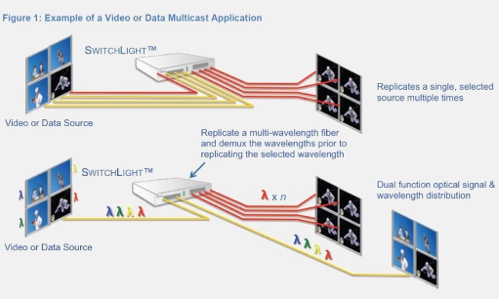There are many scenarios in today’s networks that require the replication of an optical signal, also known as optical multicast. Some of those scenarios include video feeds or data streams that need to reach multiple endpoints simultaneously. In other scenarios an expensive 40/100Gbps port may need to be replicated. In either case, current multicasting solutions create potential problems associated with congestion, cost, and latency.
Problems with Existing Multicast Solutions
Multicast is a common feature of many switches with electrical backplanes, however, with data rates at 40Gbps and above, multicasting becomes an expensive and resource intensive endeavor. 100Gbps interfaces are still relatively expensive, so multicasting a 100Gbps signal adds significant cost. In addition, multicasting 40/100Gbps signals in the electrical domain may rapidly exhaust the backplane resources. For example, a Layer 2/3 switch receives a 100Gbps signal over 4x25Gbps wavelengths. Once received, a gearbox is used to take the 4x25Gbps optical signals and convert them to 10x10Gbps electrical signals. Each of those signals has a dedicated lane within the backplane. So, if you want to multicast a single signal 8 times, 80 lanes will be required. When extrapolated multiple times, it is easy to see that even with Terabit backplanes congestion will likely occur.
Another area of concern with multicasting that exists in even lower speed 1-10Gbps networks is latency. Anytime a signal is taken from the optical domain to the electrical, some amount of delay in packet processing will be added, which creates latency. This can cost financial institutions $100s of millions of dollars every year. For video distribution, this can increase synchronization issues between multiple feeds.
Using SwitchLight™ to Overcome Multicast Challenges
Two of the strongest trends in networking today are 100Gbps networking and latency reduction. Since congestion can also be a cause of latency, the only way to avoid both of these problems is to move the multicasting function into the optical domain. The M2 Optics’ SWITCHLIGHT™ solution provides an efficient, low-latency approach for optical signal multicasting regardless of protocol, data rate, or fiber type. Thus, it addresses a number of key areas that have been discussed:
Prevent congestion: SWITCHLIGHT™ reduces the number of lanes needed for optical multicast and port replication in existing OEO (Optical-Electrical-Optical) switches.
Lower costs: Using SWITCHLIGHT™ to replicate an expensive 40/100Gbps port decreases the per port cost of multicasting optical signals by eliminating the need to provide multiple 40/100Gbps interfaces.
Reduce latency: SWITCHLIGHT’s all-optical solution eliminates the electrical conversion that OEO switches require to ensure that optical signals are multicast or replicated at the speed of light.
Lossless multicasting: SWITCHLIGHT’s lossless multicasting is truly unique as it is the first all-optical, plug-and-play solution for optical multicast and/or port replication that can eliminate the added insertion loss associated with these functions.
Future-proof the network: Being data rate and protocol agnostic, SWITCHLIGHT™ eliminates the need for upgrades for the foreseeable future. SWITCHLIGHT’s standard APIs also make integration into existing environments pain-free.

To learn more and discuss how the SWITCHLIGHT™ offers a cost-effective and resource efficient solution for optical signal multicasting and/or port replication, contact the M2 Optics team today.





